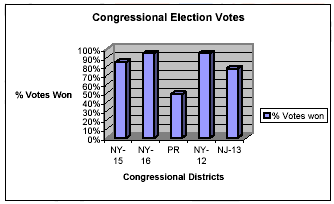| Section
4:Discussion of Findings |
|
The next logical question
would be then, if all these Dominican-Americans could vote (i.e.
were registered) and exercised their right to vote, what would
this mean politically? Do Dominican-American have a political
voice (through votes) if they were to flex their political muscle,
in concert, within say, the top 25 districts? There has not been
a close congressional race where understanding how the Dominican-American
constituency could vote would be crucial to determining the election
winner. At least, not yet. All the congressional districts within
the states found in the top 25 (NY with 12 districts, NJ with
4, FL with 4, MA with 3, and RI with 1) have not held competitive
races. All congressional election races have won by an overwhelming
majority vote, with the exception of Puerto Rico. If such, were
not the case then this would significantly change things within
many of these congressional districts. Below is a look at the
top five with the highest Dominican-American adult population.25
As one can see from Chart 1 (L to R), for the mainland CD’s Rep.
Rangel won by 85 percent of votes, Rep. Serrano by 95 percent,
Rep. Velasquez by 95 percent, and Rep. Menendez with 78 percent.
Rep. Acevedo-Vila won by 49 percent but this race is held in Puerto
Rico, and as such, cannot be compared with other congressional
races held within the mainland US. |

Source: 108th Congress, Congressional Handbook. |
| As an excerpt of
the "top 100 list," Table 2 below illustrates the top 25 of these
districts and compares these numbers with the population count of
Mexicans, Puerto Ricans, Cubans, Salvadorian, and Colombians in
these same districts. These groups were chosen because they also
happen to be the largest in Latino ethnic groups in the country.
This chart reflects the tendency of Dominicans to be concentrated
throughout the northeast and Florida. Another interesting finding
is that in the CD of NY-15, NY-5, MA-6 and RI-2, belonging to Rep.
Rangel, Rep. |
Ackerman, Rep. Tierney, and
Rep. Langevin, respectively, Dominicans outnumber Puerto Ricans.
Also, in Rep. Lincoln Diaz-Baralt’s Congressional District 21 (FL),
Colombians outnumber both Dominicans and Puerto Ricans. While Dominicans
have a slight population advantage in Rep. Pascrell’s District 8
of New Jersey and Rep. Crowley’s District 7 of New York, this may
not be the case for long. The population numbers of Mexicans in
both of these districts and of Colombians is district 7 of New York
can quickly surpass the Dominican population. |
|
|
Table 2: Top 25 Dominican Populated Congressional
Districts in the US Compared to the
"Big Six" Latino Ethnic Groups
No. |
District |
Dominican |
Mexican |
Puerto Rican |
Cuban |
Salvadorian |
Colombian |
1 |
CD - 15, NY |
123,807 |
22,569 |
71,408 |
7,100 |
1,516 |
2,389 |
2 |
CD - 16, NY |
100,801 |
23,087 |
183,125 |
4,110 |
2,230 |
1,459 |
3 |
PR* |
56,146 |
11,546 |
3,623,392 |
19,973 |
555 |
3,419 |
4 |
CD - 12, NY |
54,087 |
31,926 |
137,314 |
2,518 |
2,834 |
6,412 |
5 |
CD - 13, NJ |
35,818 |
14,585 |
89,992 |
35,507 |
11,746 |
13,988 |
6 |
CD - 8, NJ |
28,006 |
21,418 |
48,328 |
4,260 |
1,266 |
9,827 |
7 |
CD - 7, NY |
26,940 |
21,767 |
103,384 |
5,394 |
1,884 |
21,673 |
8 |
CD - 5, NY |
26,322 |
18,720 |
14,777 |
3,353 |
5,155 |
16,522 |
9 |
CD - 17, NY |
22,247 |
11,529 |
59,012 |
3,368 |
2,068 |
1,992 |
10 |
CD – 5, MA |
20,046 |
1,805 |
31,746 |
1,074 |
224 |
1,838 |
11 |
CD - 10, NY |
15,266 |
6,782 |
57,674 |
1,730 |
557 |
1,018 |
12 |
CD - 2, RI |
14,371 |
2,775 |
12,173 |
576 |
628 |
699 |
13 |
CD - 6, NY |
13,389 |
4,826 |
31,619 |
2,283 |
6,075 |
6,765 |
14 |
CD - 9, NJ |
13,105 |
4,400 |
26,335 |
12,061 |
3,195 |
11,595 |
15 |
CD - 8, MA |
11,336 |
5,778 |
29,991 |
2,309 |
10,341 |
4,858 |
16 |
CD - 21, FL |
11,151 |
5,563 |
22,698 |
256,199 |
2,039 |
24,130 |
17 |
CD - 18, NY |
10,768 |
20,597 |
22,612 |
3,210 |
1,911 |
5,512 |
18 |
CD - 17, FL |
10,461 |
3,925 |
25,720 |
29,885 |
1,052 |
8,424 |
19 |
CD - 25, FL |
10,174 |
45,228 |
29,252 |
166,540 |
3,373 |
27,327 |
20 |
CD - 9, NY |
8,809 |
5,713 |
29,104 |
2,615 |
1,652 |
8,810 |
21 |
CD - 6, MA |
8,805 |
1,891 |
6,166 |
575 |
378 |
458 |
22 |
CD - 18, FL |
8,410 |
8,459 |
17,065 |
219,700 |
3,243 |
13,584 |
23 |
CD - 4, NY |
8,331 |
4,414 |
13,568 |
2,568 |
18,628 |
4,308 |
24 |
CD - 10, NJ |
7,992 |
4,207 |
33,203 |
6,540 |
2,765 |
8,101 |
25 |
CD - 11, NY |
7,812 |
10,711 |
29,291 |
1,804 |
1,100 |
1,319 |
Source: US Census Bureau 2000; 108th Congressional Districts (100 Percent);*
The margin of error for data from Puerto Rico differs slightly from mainland, as such,
please refer to the Census based reports.
|
